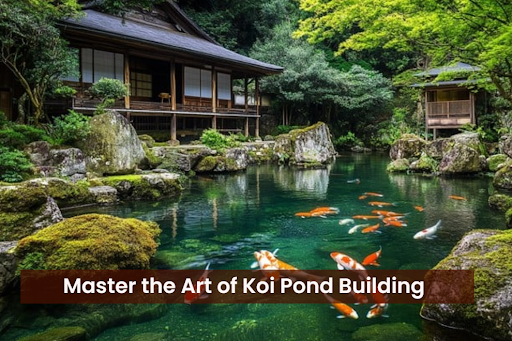Koi pond building is an art that combines aesthetics, engineering, and ecology to create a beautiful, serene retreat. Beyond its visual charm, a koi pond can serve as a sanctuary of tranquillity, symbolizing prosperity and harmony. Koi, with their vibrant colors and graceful movements, captivate onlookers and transform any space into a meditative escape.
To ensure your koi pond thrives, proper planning, construction, and ongoing care are essential. This guide focuses on koi pond building, offering step-by-step instructions for crafting and maintaining a thriving aquatic habitat.
Designing Your Koi Pond
1. Determining Pond Size and Depth
Factors to Consider:
- Number of koi you plan to keep.
- Future growth of your koi.
- Local climate and seasonal temperature fluctuations.
Ideal Depth Recommendations:
- A koi pond should be at least 3 feet deep to stabilize water temperature and deter predators.
- For larger koi, deeper ponds (up to 6 feet) are ideal to reduce stress and offer ample swimming space.
2. Choosing the Pond Shape and Materials
Aesthetic Considerations:
- Organic, irregular shapes mimic natural ponds and blend with landscaping.
- Circular or oval shapes promote better water circulation, preventing debris buildup.
Durable Material Options:
- Rubber Liners: Flexible and cost-effective for custom shapes.
- Fiberglass: Durable and easy to maintain.
- Concrete: Long-lasting but requires proper sealing to avoid leaks.
3. Filtration, Aeration, and Water Movement
Importance of Filtration:
- Filters remove waste, debris, and harmful substances, ensuring water clarity and koi health.
- Select a system compatible with your pond’s size and bio-load.
Benefits of Aeration and Circulation:
- Features like waterfalls or fountains boost oxygen levels essential for koi health.
- Water movement prevents stagnation and promotes uniform temperature distribution.
4. Protecting Your Pond
Predator Prevention:
- Install pond netting or motion-activated sprinklers to deter birds and other predators.
- Place decoys or add hiding spots like caves or plants for extra protection.
Debris Management:
- Use skimmers to collect leaves and surface debris.
- Schedule regular pond cleanings to maintain water quality.
Selecting and Caring for Koi
1. Choosing Koi Varieties
Popular Koi Types:
- Kohaku: White with red patterns.
- Sanke: White with red and black markings.
- Showa: Black with red and white accents.
- Ogon: Solid metallic shades like gold or platinum.
Balancing Colors and Patterns:
- Select a mix of koi with diverse patterns and hues for a visually appealing display.
2. Introducing New Koi
Quarantine Protocols:
- Keep new koi in a separate tank for 2-4 weeks to avoid introducing diseases.
Acclimatization Techniques:
- Gradually mix quarantine water with pond water to help koi adjust to their new environment.
- Avoid abrupt changes in temperature or water chemistry.
3. Adding Compatible Pond Life
Companion Species:
- Consider adding goldfish, sturgeon, or minnows for a harmonious ecosystem.
Aquatic Plants and Benefits:
- Include oxygenating plants like anacharis for natural water purification.
- Use potted water lilies to prevent koi from uprooting them.
Maintaining Your Koi Pond
1. Monitoring Water Quality
Key Parameters:
- pH: Maintain between 6.5 and 8.0.
- Ammonia, Nitrites, Nitrates: Keep levels minimal for koi health.
- Temperature: Ensure stable conditions throughout the seasons.
Testing Tools:
- Use water testing kits or digital meters for accurate results.
- Test weekly and after weather changes to catch issues early.
2. Routine Maintenance
Regular Cleaning:
- Clean filter media and skimmers frequently.
- Inspect pumps, hoses, and other equipment for wear.
Seasonal Adjustments:
- Use heaters or de-icers in winter to prevent freezing.
- Add shade structures or floating plants in summer to reduce algae growth and overheating.
3. Observing Koi Health
Warning Signs:
- Look for abnormal swimming, appetite loss, or physical changes like discoloration.
Interventions:
- Isolate unwell koi and seek veterinary advice.
- Treat with medications or salt baths as needed.
Enhancing Pond Aesthetics
1. Landscaping Ideas
Plant Suggestions:
- Surround your pond with ferns, hostas, or ornamental grasses.
- Add stepping stones or a small wooden bridge for charm.
Lighting and Water Features:
- Install LED lights for evening ambiance.
- Include waterfalls or streams for soothing sounds and visual appeal.
2. Creating a Balanced Ecosystem
Promoting Biodiversity:
- Incorporate fish, plants, and invertebrates for a self-sustaining pond.
Shade and Cover:
- Use floating plants to provide natural shade and reduce algae growth.
- Add rocks or logs for koi hiding spots.
Conclusion
Koi pond building is a fulfilling endeavor that enhances your outdoor space while creating a tranquil retreat. By focusing on design, construction, and maintenance, you can craft a vibrant koi pond that thrives for years. With proper planning and care, your pond will become a harmonious sanctuary where nature and artistry meet.
FAQs
1. How deep should a koi pond be?
A koi pond should be at least 3 feet deep, with 4-6 feet recommended for larger koi and better water stability.
2. What filtration system works best for koi ponds?
Select a filtration system that matches your pond’s size and bio-load. Pressurized filters or multi-chamber systems are excellent options.
3. Can I add plants to my koi pond?
Yes, but use potted plants like water lilies to prevent koi from uprooting them.
4. How do I protect my koi from predators?
Install netting, use decoys, or provide hiding spots like caves and rocks.
5. What are good koi varieties for beginners?
Kohaku, Ogon, and Sanke are great choices for their resilience and beauty.



